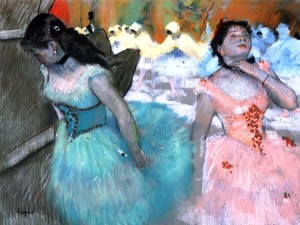 Happy New Year ! This month’s entry is written by guest blogger, Shery Scott, serious amateur dancer (and AiB board member). Welcome Shery:
Happy New Year ! This month’s entry is written by guest blogger, Shery Scott, serious amateur dancer (and AiB board member). Welcome Shery:
At this time of year, many of us are looking back over 2013 to assess our lifestyles and planning to make the necessary improvements that we know we need, most notably, increasing physical exercise. Typically, however, most people will have lost their motivation to make good on their new year’s resolutions by about January 12th.
There is a better way! Build it into your weekly schedule. Yes, I know you’ve heard it before; but it’s so true, it bears repeating: positive changes will last longer if you have accountability. For myself and my fellow classmates, this means attending a ballet class at least once a week. And don’t think your age works as an excuse: I’m over 50 and my ballet instructor is over 60. If we can still do it, anyone can. And the good news is that dance, and ballet, in particular, provide much more than just physical exercise. It provides a whole host of other benefits, too.
Physical Benefits
Dancing develops and requires balance, strength, stamina, and flexibility. That by itself is reason enough to dig your workout clothes out of the closet. But there’s much more to be gained (better health)…and lost (fat). Increasing your weekly exercise can also reduce your stress, blood pressure, cholesterol, and triglycerides. And it can increase your lung capacity and heart and lung efficiency.
Mental Benefits
First and foremost, dancing will boost your endorphins and improve your mental clarity and memory. My instructor is fond of saying, “I don’t need to do crossword puzzles; I do ballet.” Why? Because dancing forces you to use your brain in ways you might not otherwise. First, you need to be able to remember the combinations so you can do them. Don’t worry; nobody expects you to do anything well the first time you try. You’ll get better with practice. Second, you’ll be performing the same moves on the left side of your body as you do on the right side of your body. That means dancing helps you develop mental lateral facility. That’s important for those of us who are profoundly right-handed or left-handed to help create better development and balance on our weaker side.
Social Benefits
Unless you’re springing for private lessons, a dance class is a great way to meet new people and enlarge your social circle. In my own ballet class, I have met some wonderful women who provide me much-needed comic relief when I’m struggling to learn a new move, or if I’m having a difficult time in my personal life. I can’t imagine life without them.
Emotional Benefits
Once you get moving and get into the swing of things, you will feel better. I dread getting up to go to class in the evenings, especially when it’s so dark in the winter months. But I have never ever regretted going to class, not once. I always feel so much better about myself and my life after I’ve worked hard in class. And you will, too.
Spiritual Benefits
For those of us of Judeo-Christian orientation, the book of 2 Samuel 6:14 tells us that King David “danced before the Lord with all his might.” That’s an excellent example for us to follow. Even if you’re not of religious inclination, dancing can be a way to express your cultural identity and your spirituality.
So with all this going for you, why wouldn’t you take a chance and contact your local dance studio to sign up for a class? Most of them have introductory specials this time of year, so go ahead and take advantage. Just don’t be surprised if you leave the studio physically worn out and emotionally exhilarated. Of course it’s hard; it’s ballet. If it were easy, it would be called football.
